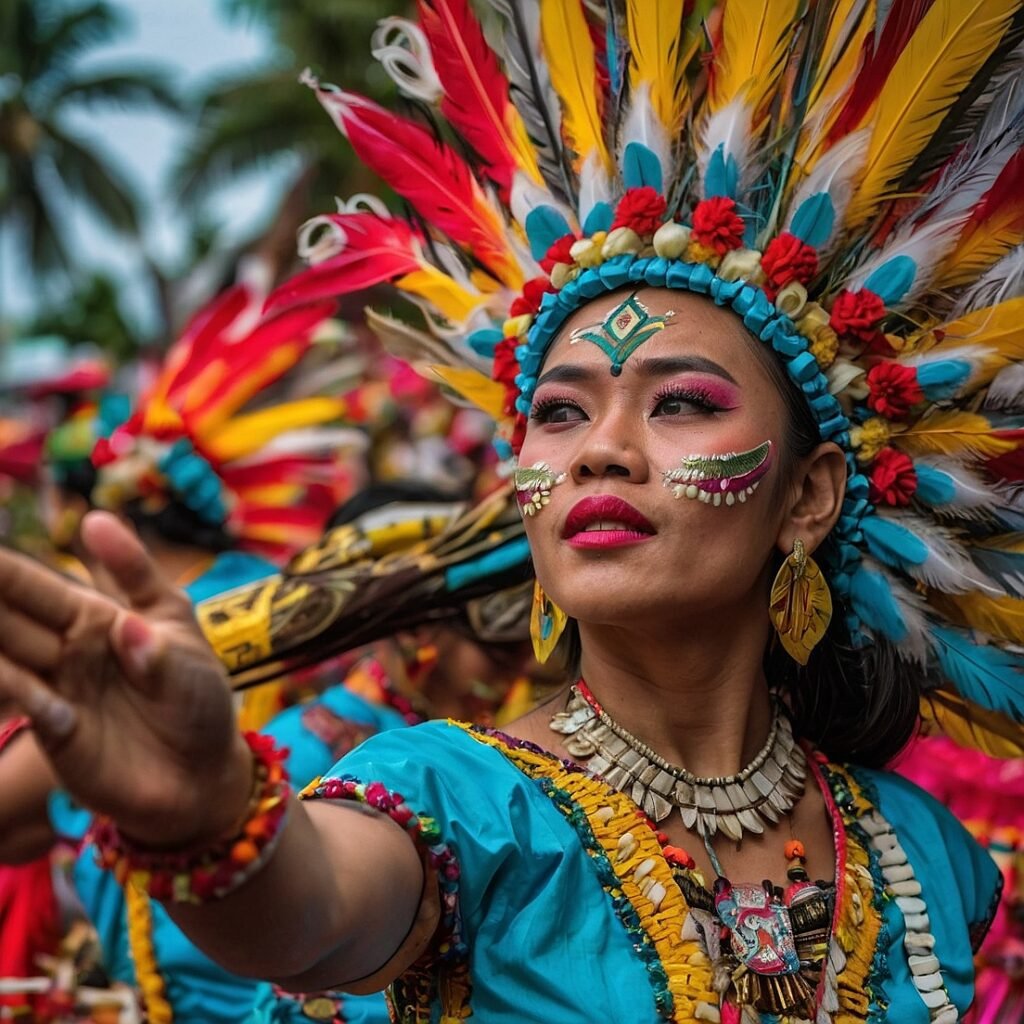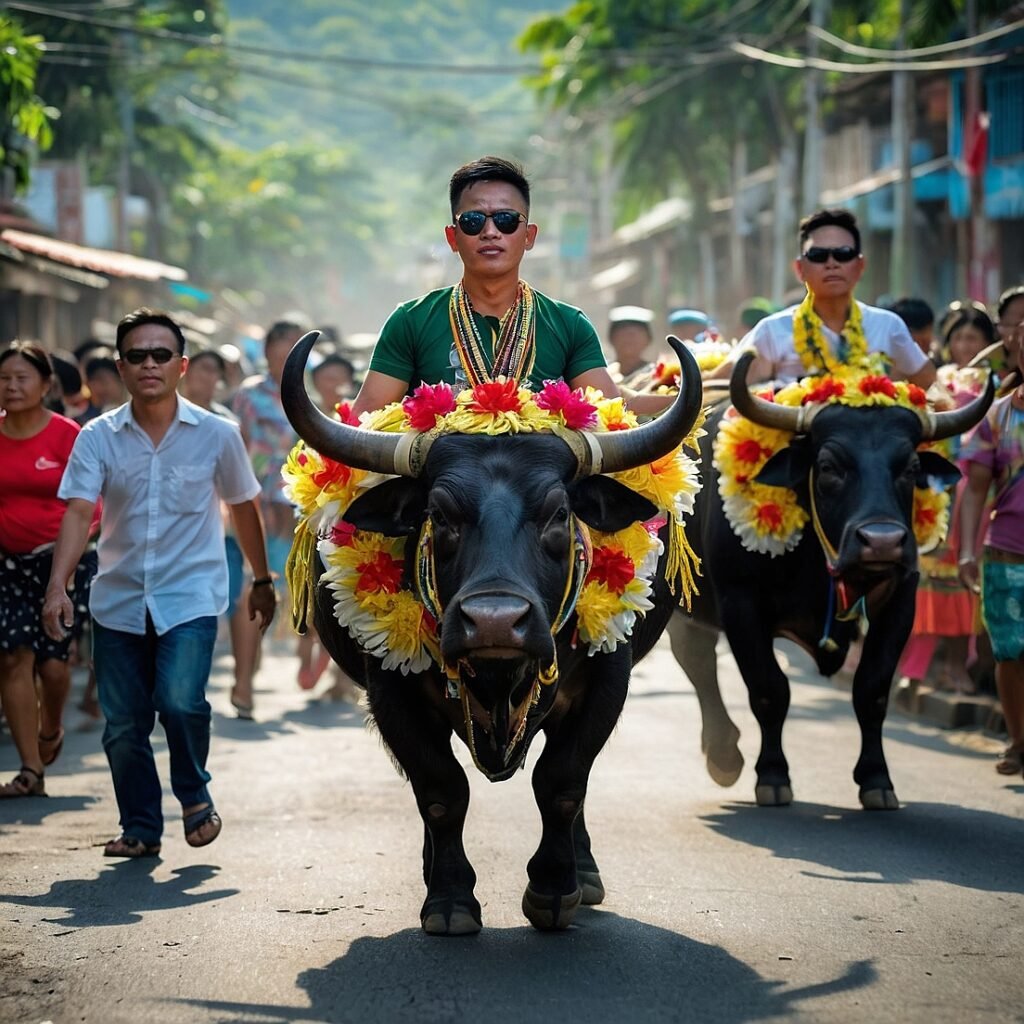Hey there, festival enthusiasts and culture lovers! Have you ever heard of the Ati-Atihan Festival? If not, you’re in for a treat! Today, we’re diving deep into the vibrant world of Ati-Atihan Sa Kalibo, often hailed as the “Queen of All Philippine Festivals.” This isn’t just any ordinary celebration – it’s a riot of colors, rhythms, and traditions that will leave you breathless and yearning for more. So, grab your imaginary tribal paint and feathers, and let’s embark on a journey to the heart of Kalibo, Aklan, where this magnificent festival unfolds every January.
The Origins: A Tale of Friendship and Cultural Exchange
The Legend of the Ten Bornean Datus
Every great festival has an origin story, and Ati-Atihan is no exception. Picture this: it’s the 13th century, and ten Bornean datus (chieftains) have just arrived on the shores of Panay Island. They’re seeking refuge from their homeland, and they encounter the indigenous Ati people, known for their dark skin and short stature. Now, you might think this would lead to conflict, but here’s where the story takes a heartwarming turn.
The Bornean datus, led by Datu Puti, negotiate with the Ati chieftain, Marikudo, and his wife, Maniwantiwan. In a gesture of goodwill, they trade gold and a golden salakot (a traditional hat) for land to settle on. This peaceful exchange marks the beginning of a beautiful friendship between the newcomers and the Ati people.
The First Ati-Atihan Celebration
Fast forward a bit, and the Bornean settlers are thriving on their new land. But they haven’t forgotten the kindness of the Ati people. To show their gratitude and respect, they decide to do something truly special. They darken their skin with soot and don clothing similar to the Ati. This act of imitation – “Ati-Atihan” in the local language – becomes the foundation of the festival we know today.
The Evolution: From Pagan Ritual to Christian Feast
The Pre-Colonial Celebration
Before the arrival of Christianity in the Philippines, the Ati-Atihan was primarily a pagan animistic ritual. It was a way for the people to honor their anitos (ancestral spirits) and give thanks for a bountiful harvest. The celebration was wild, spontaneous, and deeply rooted in the natural world.
The Spanish Influence
When the Spanish colonizers arrived in the 16th century, they saw an opportunity to blend this popular local festival with Christian traditions. They introduced the veneration of the Santo Niño (Holy Child Jesus) into the celebration. This clever fusion allowed the indigenous people to continue their beloved festival while embracing the new religion.
The Modern Ati-Atihan
Today, the Ati-Atihan Festival is a unique blend of indigenous traditions and Catholic faith. It’s a testament to the Filipino people’s ability to adapt and create something entirely new and beautiful from diverse cultural influences. The festival now spans several days, culminating in a grand parade that combines tribal dances, colorful costumes, and religious processions.
The Festival Experience: A Sensory Overload
The Sights: A Kaleidoscope of Colors
Imagine stepping into a world where every color of the rainbow comes to life in the most vibrant way possible. That’s what you’ll see at Ati-Atihan. Revelers paint their faces and bodies in bold tribal patterns, using dark paint to mimic the appearance of the Ati people. Elaborate headdresses adorned with feathers, shells, and flowers bob up and down in the sea of people. Costumes range from traditional tribal wear to fantastical creations that push the boundaries of imagination.
The Sounds: The Heartbeat of the Festival
Close your eyes for a moment and listen. Do you hear it? The incessant, hypnotic rhythm of drums and percussion instruments fills the air. “Hala Bira! Pwera Pasma!” – the festival’s rallying cry – echoes through the streets. It’s a phrase that roughly translates to “Keep on going! No stopping!” And indeed, the energy of Ati-Atihan never seems to wane.
The Movement: Dance Like Nobody’s Watching
At Ati-Atihan, everyone’s a dancer. The streets become one massive dance floor as participants and spectators alike are swept up in the infectious rhythm. The traditional “sadsad” step – a simple two-step movement – is easy for anyone to pick up. Before you know it, you’ll find yourself swaying and stepping to the beat, caught up in the joyous atmosphere.
The Tastes: A Culinary Adventure
No Filipino festival would be complete without food, and Ati-Atihan doesn’t disappoint. Street vendors line the roads, offering a smorgasbord of local delicacies. From savory lechon (roasted pig) to sweet bibingka (rice cake), your taste buds are in for a treat. Don’t forget to try the local Aklanon delicacies like inubarang manok (chicken cooked in coconut milk) and binakol (chicken soup cooked in bamboo).
The Schedule: A Week-Long Extravaganza
The Opening Salvo
The festival officially kicks off with the “Pamukaw” or opening salvo. This early morning ritual involves rousing the town with drum beats and bugles, signaling the start of the festivities. It’s like an alarm clock, but way more fun!
The Religious Aspect
Throughout the week, various religious activities take place. These include novena masses, processions, and the fluvial parade of the Santo Niño. Even if you’re not religious, the solemnity and beauty of these events are worth experiencing.
The Tribal Dance Competition
One of the highlights of the festival is the tribal dance competition. Different groups showcase their interpretation of traditional Ati dances, complete with stunning costumes and props. It’s a spectacle of creativity and athleticism that will leave you in awe.
The Grand Parade
The climax of Ati-Atihan is the grand parade on the final Sunday. This is when all the participating groups come together in a massive display of music, dance, and color. The parade winds through the streets of Kalibo, with each group trying to outdo the others in terms of energy and spectacle.
The Impact: More Than Just a Party
Cultural Preservation
While Ati-Atihan is undoubtedly a fantastic party, it serves a deeper purpose. The festival plays a crucial role in preserving and celebrating the cultural heritage of the Aklanon people. It’s a living link to the past, keeping ancient traditions alive in the modern world.
Economic Boost
The festival is also a significant economic driver for Kalibo and the surrounding areas. During Ati-Atihan, the town’s population swells with tourists from all over the Philippines and around the world. This influx of visitors provides a substantial boost to local businesses, from hotels and restaurants to souvenir shops and transportation services.
Community Bonding
Perhaps most importantly, Ati-Atihan serves as a powerful force for community bonding. Preparing for and participating in the festival brings people together, strengthening social ties and fostering a sense of shared identity and pride.
Ati-Atihan vs. Other Filipino Festivals
To give you a better idea of how Ati-Atihan stands out, let’s compare it to some other famous Filipino festivals:
| Festival | Location | Main Feature | Date |
|---|---|---|---|
| Ati-Atihan | Kalibo, Aklan | Tribal dance, Santo Niño devotion | 3rd Sunday of January |
| Sinulog | Cebu City | Santo Niño devotion, street dance | 3rd Sunday of January |
| Dinagyang | Iloilo City | Warrior dance, Santo Niño devotion | 4th Sunday of January |
| Maskara | Bacolod City | Masked street dance | October |
| Panagbenga | Baguio City | Flower festival, street parade | February |
While all these festivals are spectacular in their own right, Ati-Atihan stands out for its spontaneity and the way it encourages participation from everyone, not just official performers.
Tips for Attending Ati-Atihan
Plan Ahead
Ati-Atihan is a popular festival, so it’s wise to book your accommodations and transportation well in advance. Kalibo can get pretty crowded during the festival week!
Dress Appropriately
Comfortable clothes and shoes are a must. You’ll be doing a lot of walking and dancing. Don’t worry about dressing up – the more casual and comfortable, the better.
Join In
The beauty of Ati-Atihan is that everyone’s invited to participate. Don’t be shy – grab some face paint, join a dancing group, and lose yourself in the rhythm.
Stay Hydrated
With all the dancing and excitement, it’s easy to get dehydrated. Make sure to drink plenty of water throughout the day.
Respect Local Customs
While Ati-Atihan is a joyous celebration, remember that it has deep cultural and religious significance for many participants. Be respectful, especially during the religious portions of the festival.
The Future of Ati-Atihan: Tradition Meets Modernity
As we look to the future, it’s clear that Ati-Atihan will continue to evolve while staying true to its roots. The organizers are working hard to balance the preservation of traditional elements with the need to appeal to younger generations and international tourists.
One exciting development is the increasing focus on environmental sustainability. In recent years, there have been efforts to make the festival more eco-friendly, with initiatives to reduce plastic waste and promote recycling.
There’s also a growing emphasis on educating visitors about the true history and cultural significance of Ati-Atihan. This helps ensure that the festival remains a meaningful celebration of Aklanon heritage, rather than just a tourist attraction.
Conclusion: The Spirit of Ati-Atihan
As our journey through the world of Ati-Atihan comes to an end, I hope you’ve caught a glimpse of what makes this festival so special. It’s more than just a party or a tourist attraction – it’s a living, breathing embodiment of Filipino culture, resilience, and joy.
Ati-Atihan reminds us of the power of cultural exchange and mutual respect. It shows us how traditions can evolve and adapt without losing their essence. And most of all, it teaches us the importance of coming together as a community to celebrate life, faith, and our shared humanity.
So, whether you’re planning your next adventure or simply dreaming of far-off places, keep Ati-Atihan Sa Kalibo in mind. Who knows? Maybe next January, you’ll find yourself in the heart of Kalibo, face painted, feathers in your hair, dancing to the rhythm of the drums and shouting “Hala Bira! Pwera Pasma!” along with thousands of new friends.
Until then, let’s carry the spirit of Ati-Atihan with us – a spirit of joy, inclusivity, and celebration of our diverse cultural heritage. After all, isn’t that what life’s all about?
Disclaimer: This article aims to provide accurate information about the Ati-Atihan Festival based on available data up to 2021. However, festival details and practices may change over time. We encourage readers to verify current information with official sources when planning to attend the festival. If you notice any inaccuracies, please report them so we can correct them promptly.




